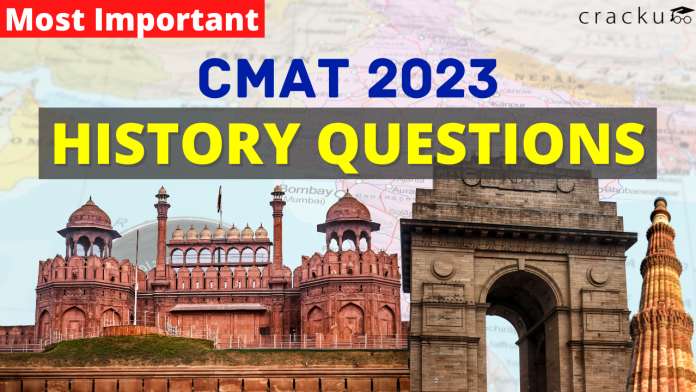CMAT GK History Important Questions [PDF]
History is one of the most important topic in the CMAT GK, and also it is a scoring section. One can utilize this article which consists of the most important GK questions regarding History. Cracku provides you with the Top 20 very Important History Questions for CMAT based on the questions asked in previous exam papers. Click on the link below to download the History Questions for CMAT PDF with detailed answers.
Download History Questions for CMAT
Enroll to CMAT 2023 Crash Course
Question 1: Where did Babar die?
a) Agra
b) Delhi
c) Kabul
d) Lahore
1) Answer (A)
Solution:
Babar died in Agra during the year 1530.
Question 2: During the time of Confucius, China was under the rule of which of the following dynasties?
a) Chau
b) Sunga
c) Sui
d) Han
2) Answer (D)
Solution:
During the time of Confucius (206 BCE-220 CE), China was under the rule of Han dynasty.
Question 3: Which of the following facts is not true about Mahatma Gandhi?
a) He was chosen for the Nobel Peace Prize in 1948, but because of his unfortunate assassination, the Peace Prize was not awarded that year.
b) Time magazine named him the “Man of the Year” in 1930.
c) In 1999, he was declared the “Person of the Century” by the Time magazine, and the runner-up was Albert Einstein.
d) He was shoved out a train in 1893 in Pietermaritzburg in KwaZulu Natal province of South Africa, because he refused to move to a third class coach while holding a first class ticket.
3) Answer (C)
Solution:
In 1930, Mahatma Gandhi was declared as the Person of the year by TIME magazine.
Hence, option C is the correct answer.
Question 4: Under an agreement with which of the following countries did Subhash Chandra Bose organise the Indian soldiers into Azad Hind Fauj?
a) Germany
b) Japan
c) Italy
d) Russia
4) Answer (B)
Solution:
The Provisional Government of Free India, or, more simply, Free India (Azad Hind), was an Indian provisional government established in occupied Singapore in 1943 and supported by the Empire of Japan, Nazi Germany, Italian Social Republic, and their allies.
It was a part of a political movement originating in the 1940s outside India with the purpose of allying with the Axis powers to free India from British Rule. It was established by Indian nationalists-in-exile during the latter part of the Second World War in Singapore with monetary, military and political assistance from Imperial Japan. Founded on 21 October 1943, the government was inspired by the concepts of Subhas Chandra Bose who was also the leader of the government and the Head of State of this Provisional Indian Government-in-exile. The government proclaimed authority over Indian civilian and military personnel in Southeast Asian British colonial territory and prospective authority over Indian territory to fall to the Japanese forces and the Indian National Army during the Japanese thrust towards India during the Second World War. The government of Azad Hind had its own currency, court and civil code, and in the eyes of some Indians its existence gave a greater legitimacy to the independence struggle against the British.
However, while it possessed all the nominal requisites of a legitimate government, it lacked large and definite areas of sovereign territory until Japan gave it nominal authority of the Andaman and Nicobar Islands in 1943 and the occupation of parts of Manipur and Nagaland. Japanese officials made all the decisions, and throughout its existence it was entirely dependent on Japanese support.
Immediately after the formation of the government-in-exile, Azad Hind declared war against the Anglo-American allied forces on the Indo-Burma Front. Its army, the “Azad Hind Fauj” (Indian National Army or the INA), went into action against the British Indian Armyand the allied forces as part of the Imperial Japanese Army in the Imphal-Kohima sector. The INA had its first major engagement at the Battle of Imphal where, under the command of the Japanese Fifteenth Army, it breached the British defences in Kohima, reaching the salient of Moirang before suffering a catastrophic defeat as the Allied forces held, and Allied air dominance and compromised supply lines forced both the Japanese and the INA to retreat.
Question 5: Which religion was propounded by Mughal Emperor Akbar in 1582 A.D., with the intention of merging the best elements of different religions?
a) Akbarnama
b) Ain-i-Akbari
c) Zij-i-Ilkhani
d) Din-e-Ilahi
5) Answer (D)
Solution:
The Din-e-Ilahi was a syncretic religion propounded by the Mughal emperor Akbar in 1582 CE, intending to merge some of the elements of the religions of his empire, and thereby reconcile the differences that divided his subjects. The elements were primarily drawn from Islam and Hinduism, but some others were also taken from Christianity, Jainism, Sikhism and Zoroastrianism.
Question 6: Who built Jama Masjid?
a) Guru Ramdas
b) Shah Jahan
c) Rao Jodhaji
d) Mahatma Gandhi
6) Answer (B)
Solution:
Mughal emperor Shah Jahan built the Jama Masjid between 1644 and 1656.
=> Ans – (B)
Question 7: Battle of Haldighati was fought in the year ________.
a) 1764
b) 1526
c) 1576
d) 1857
7) Answer (C)
Solution:
The Battle of Haldighati was fought on 18 June 1576 between cavalry and archers supporting the Rana of Mewar, Maharana Pratap and the Mughal emperor Akbar’s forces in Rajasthan.
=> Ans – (C)
Question 8: Some of the famous battles are listed below:
1.The Battle of Cajamarca
2.The Battle of Huai-Hai
3.The Battle of Plassey
4.The Battle of Stalingrad
5.The Battle of Waterloo
6.The Battle of Yorktown
Which of the following is the correct chronological order of the above battles?
a) 1-2-3-4-5-6
b) 1-2-6-3-5-4
c) 1-3-6-5-4-2
d) 2-1-3-6-4-5
e) 2-6-1-3-4-5
8) Answer (C)
Solution:
The Battle of Cajamarca was fought in 1532 between the Incas and Spaniards.
The Battle of Huai Hai was fought in 1948. It was a part of the Chinese civil war.
The Battle of Plassey was fought in 1757 between the British East India Company and the Nawab of Bengal.
The Battle of Stalingrad was fought between 1942 and 1943. It was fought between the German and the Soviet forces. It is considered to be the largest battle of World War II.
The Battle of Waterloo was fought in 1815 between the French and the British. Napoleon Bonaparte was defeated in the battle of Waterloo.
The Battle of Yorktown was fought in 1781.
Therefore, the correct order is 1-3-6-5-4-2. Therefore, option C is the right answer.
Question 9: Whom did ashoka appoint to spread buddhism to many parts of asia
a) Nagarikas
b) adhyakshas
c) mahamatras
d) dharma mahamatras
9) Answer (D)
Solution:
Ashoka appointed Dharma Mahamatras to spread Buddhism to many parts of Asia.
Question 10: under whose leadrship the sikhs beacme a political and military force ?
a) Guru Har Rai
b) Guru Har Kishan
c) Guru Tegh Bahadur
d) Guru Gobind Singh
10) Answer (D)
Solution:
Under the leadership of Guru Gobind Singh, Sikhs became a political force and military force.
Question 11: Khajuraho was the capital of
a) Paramaras
b) Chauhans
c) Chandelas
d) Rathods
11) Answer (C)
Solution:
Khajuraho was an ancient city in the state of Madhya Pradesh and it was the capital of Chandela Kings who ruled Bundelkhand.
Question 12: During the British rule, the only British King to visit India and hold a grand Durban was
a) Edward VII
b) George V
c) James II
d) James VII
12) Answer (B)
Solution:
King George V was the only British King to visit India and hold a grand Durban during the British rule in India.
Question 13: Who propounded the Panchsheel Principles?
a) Mahatma Gandhi
b) Lord Buddha
c) Pandit Jawahar Lal Nehru
d) Swami Dayanand Saraswati
13) Answer (C)
Solution:
First Prime Minister of India Pandit Jawaharlal Nehru emphasized the Panchsheel Principles.
Question 14: There were 8 types of marriages during the Vedic Period. Which one of them is a love marriage?
a) Brahma Vivah
b) Gandharva Vivah
c) Daiva Vivah
d) Arsha Vivah
14) Answer (B)
Solution:
Gandharva Vivah is one of the love marriage during the Vedic Period.
=> Ans – (B)
Question 15: Who was the German General nicknamed ‘Desert Fox’ during the Second World War?
a) General Nelson
b) General Erwin Rommel
c) Adolf Hitlar
d) No option is correct.
15) Answer (B)
Solution:
General Erwin Rommel was the German General nicknamed ‘Desert Fox’ during the Second World War.
=> Ans – (B)
Question 16: Under which treaty British company got the Diwani right of Bengal, Bihar and Orissa from Mughal ruler Shah Alam II?
a) Treaty of Awadh
b) Treaty of Alinagar
c) Treaty of Calcutta
d) Treaty of Allahabad
16) Answer (D)
Solution:
British company got the Diwani right of Bengal, Bihar and Orissa from Mughal ruler Shah Alam II under the Treaty of Allahabad.
=> Ans – (D)
Question 17: Who was the first President of the Indian National Congress?
a) Womesh Chunder Bonnerjee
b) Bal Gangadhar Tilak
c) Allan Octavian Hume
d) Dadabhai Naoroji
17) Answer (A)
Solution:
After the party’s foundation in 1885, Womesh Chunder Bonnerjee became its first president. A total of sixty one people have served as the president of the Indian National Congress.
Question 18: Jahangir was the ………. Mughal emperor of India.
a) $3^{rd}$
b) $4^{th}$
c) $5^{th}$
d) $6^{th}$
18) Answer (B)
Solution:
Babur—>Humayun—> Akbar—>Jahagir hence jahagir was the 4th ruler of the mughals





